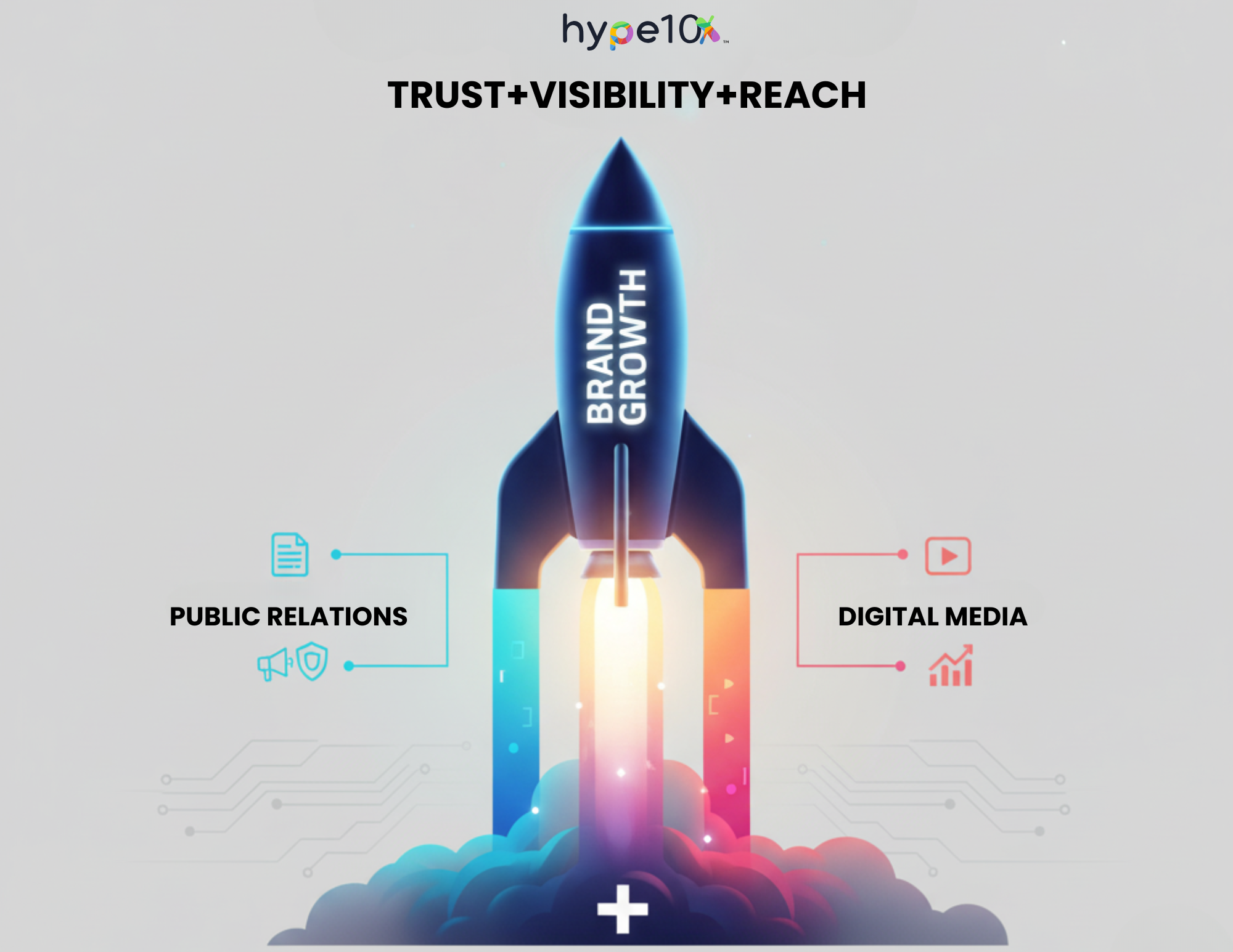The Fusion of PR and Digital Media: A New Era of Brand Amplification
Public Relations (PR) is the strategic process of managing a company’s reputation and relationship with the public. Traditionally, this involved crafting press releases, organizing events, and securing media coverage in newspapers and television. Digital media, on the other hand, encompasses all online channels, from social media platforms and blogs to online news portals and video-sharing sites. Once considered separate disciplines, the two have now become deeply and inextricably linked. The rise of digital technology has completely reshaped the media landscape, blurring the lines between traditional PR and online marketing. Today, a successful PR strategy is incomplete without a robust digital component. The two are no longer separate because digital platforms are the primary way information is consumed, shared, and discussed, making them essential for reaching and engaging with modern audiences. This powerful fusion of digital and traditional tactics is what we now call Digital PR, a strategy designed to not only manage reputation but also to generate online visibility, backlinks, and authority. In this new era, leveraging digital PR is the key to amplifying your brand’s presence and ensuring your message resonates in a noisy online world.
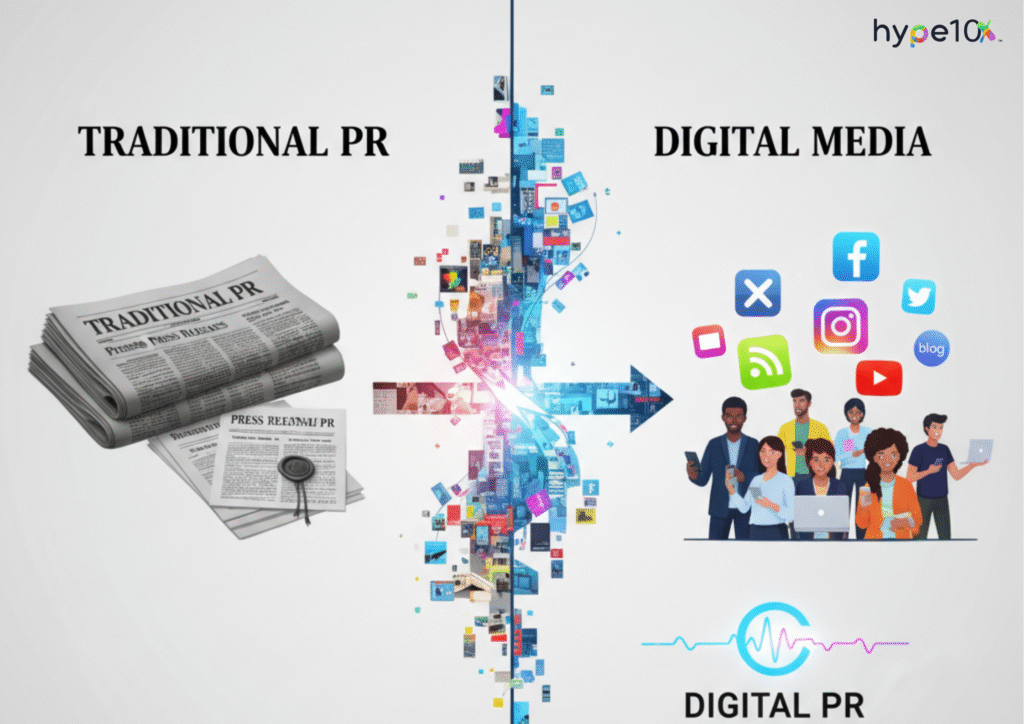
The Evolution of PR in the Digital Era
The landscape of public relations has undergone a seismic transformation, moving far beyond the confines of a traditional press room. For decades, PR was a linear process defined by print, radio, and television. The primary objective was to secure coverage through formal press releases and carefully cultivated relationships with a few powerful journalists—the “gatekeepers” who held the keys to public attention. This model was a one-way street: a company delivered its message to a journalist, who in turn shared it with a mass audience.
Today, that linear model has been shattered by the digital revolution. The internet has democratized media, giving rise to an endless array of digital channels, from corporate blogs and engaging podcasts to viral social media campaigns and influencer collaborations. The power has shifted from a handful of journalists to a vast network of online creators and digital influencers. These new gatekeepers, with their specialized audiences and authentic voices, now wield immense influence, often surpassing the reach of traditional media outlets.
For example, a product launch is no longer just announced in a newspaper; it is now shared in real-time on a company’s Instagram, reviewed by a tech blogger on YouTube, and discussed in a dedicated subreddit. This shift requires PR professionals to think like content creators and marketers, focusing not just on a single story but on a continuous stream of engaging, shareable content. This evolution from a controlled, one-way broadcast to a dynamic, two-way conversation is the defining feature of modern PR, emphasizing direct engagement, community building, and measurable online impact.
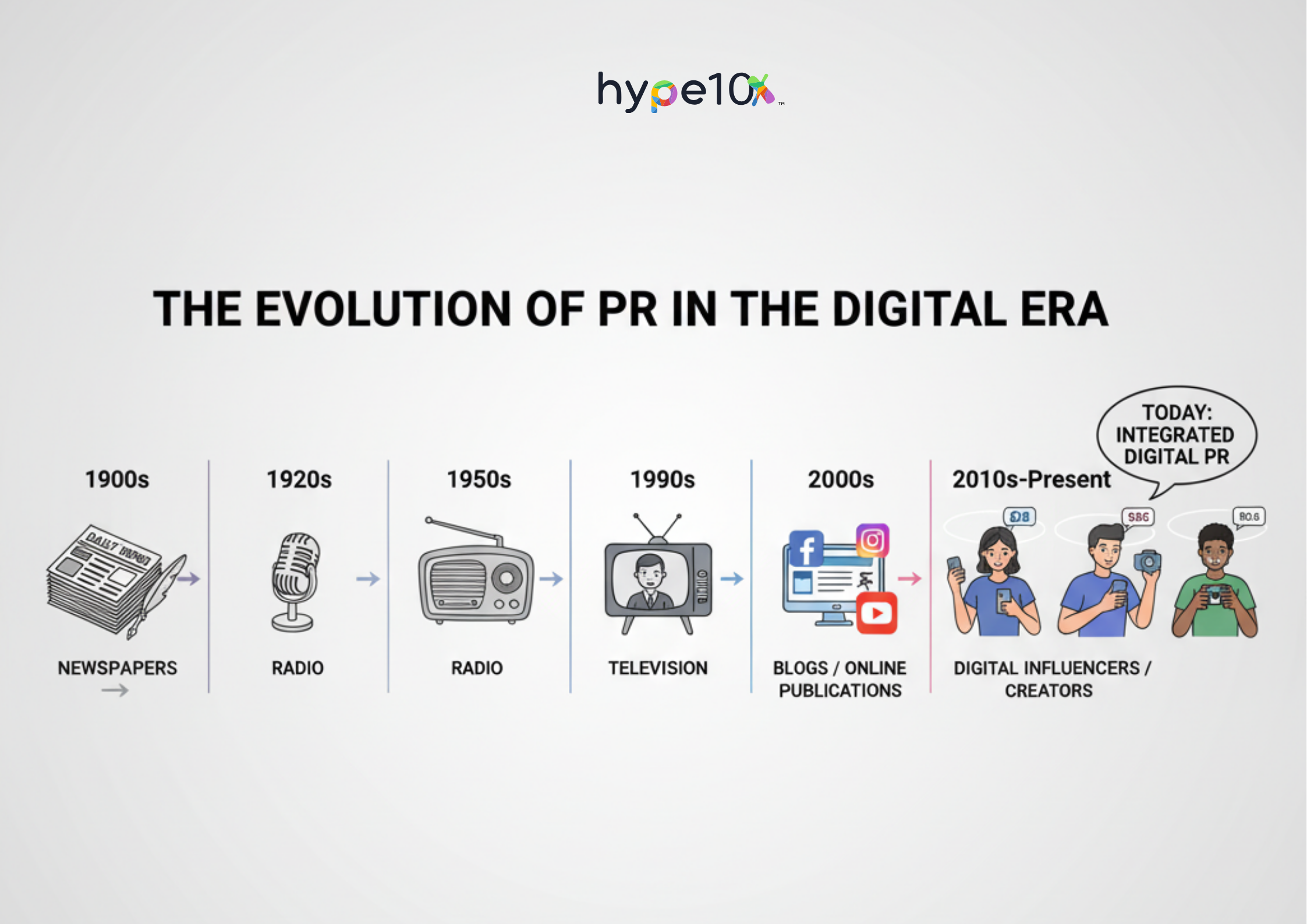
Core Roles of PR and Digital Media
While Public Relations (PR) and Digital Media have distinct functions, they are most effective when they work together, forming a synergistic relationship that amplifies brand reach and influence. PR focuses on the core message and the brand’s identity. Its primary roles are reputation management, brand credibility, and storytelling. It builds trust and authority by securing third-party validation through media mentions, awards, and positive word-of-mouth, creating the foundational narrative that a brand stands for.
In contrast, Digital Media provides the tools for amplification, audience targeting, and real-time engagement. It’s the engine that powers the PR message. Once PR crafts a compelling story, digital media can disseminate it to a massive, segmented audience through platforms like social media, blogs, and video channels. Digital tools allow brands to pinpoint specific demographics and interests, ensuring the right message reaches the right people. Moreover, digital media enables direct, two-way communication, allowing for immediate feedback and dynamic conversations that build a loyal community.
They are not in competition but are deeply complementary. PR establishes the “what” and “why”—the credible story—while digital media provides the “how” and “where”—the powerful delivery system. For instance, a traditional press release announcing a company’s new initiative (PR) can be simultaneously distributed online, shared by influencers, and used as the basis for a social media campaign (Digital Media). The press release provides the authority, and the digital channels give it momentum and real-time interaction. Together, they create a comprehensive strategy that not only builds trust but also drives tangible online engagement and visibility.
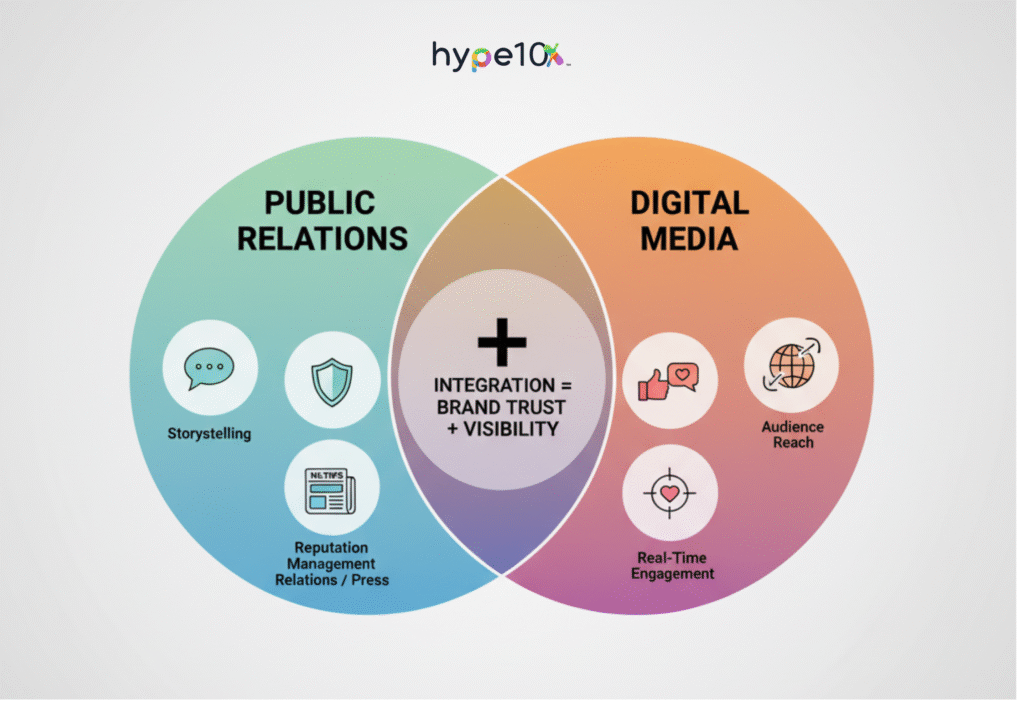
The Synergistic Benefits of Integrating PR with Digital Media
The convergence of PR and digital media is not just a trend; it is a fundamental shift that unlocks a host of powerful benefits for modern brands. The most immediate advantage is achieving greater reach and visibility. Traditional PR often relies on securing a single, impactful placement in a major newspaper or magazine. While valuable, that reach is often finite. By integrating digital media, a press release can be amplified across a company blog, shared by influencers on Instagram, and discussed in a LinkedIn post, creating a multi-channel narrative that extends far beyond the original outlet.
This amplified reach is directly tied to a second, critical benefit: building authority through SEO. A key objective of Digital PR is to earn high-quality backlinks from reputable online publications and blogs. These backlinks, which are essentially digital votes of confidence, signal to search engines like Google that a brand is trustworthy and authoritative. This improves a website’s search engine ranking, leading to more organic traffic and enhanced long-term visibility. A single, well-placed article can generate dozens of backlinks, building a robust online foundation that continues to drive results long after the initial news cycle.
Furthermore, this integration transforms the communication process from a one-way announcement to a dynamic, two-way conversation. Traditional PR was about broadcasting a message; digital PR is about engaging in dialogue. Social media listening and community engagement allow brands to gather real-time feedback, address customer concerns instantly, and participate in conversations about their industry. This direct interaction builds brand loyalty and humanizes the company in a way that a formal press release never could.
Finally, the fusion of these two fields enables data-driven strategies. PR was once difficult to measure with precision, often relying on anecdotal evidence and estimated ad value. With digital tools, every campaign can be tracked. Analytics can measure website traffic from a new article, social listening tools can gauge sentiment and measure brand mentions, and conversion rates can be directly tied to PR efforts. This data allows for continuous optimization, proving the ROI of PR campaigns and enabling brands to make smarter, more informed decisions for future initiatives. Together, PR and digital media create a loop of communication, trust-building, and measurable growth.
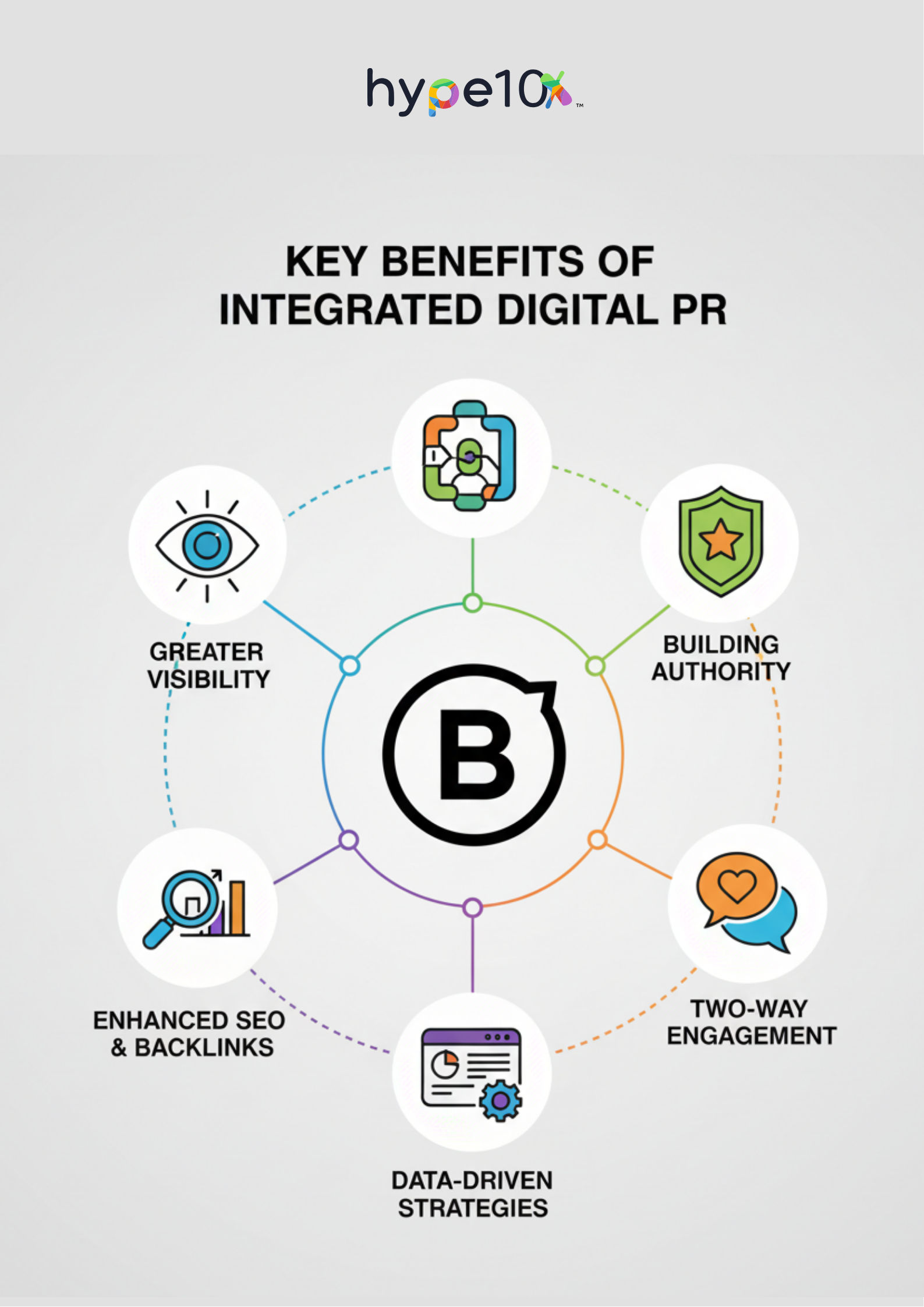
Digital PR Tactics Businesses Can Use
1. Online Press Releases and Media Coverage
Instead of solely relying on traditional wire services, businesses now distribute press releases through digital channels like email lists and online newsrooms. They also pitch stories directly to digital journalists and bloggers who cover their industry. Securing coverage in online publications not only gets the message out but also provides a valuable backlink to the company’s website, boosting its SEO.
2. Collaborating with Influencers & Digital Creators
Influencers and digital creators have become powerful gatekeepers with dedicated, engaged followings. Collaborating with them is a highly effective PR tactic. Businesses can partner with relevant influencers for product reviews, sponsored content, or brand ambassadorships. The key is to choose creators whose values and audience align with the brand’s. This peer-to-peer recommendation feels authentic and can generate significant trust and sales.
3. Leveraging Social Media for PR Campaigns
Social media is a real-time PR tool. Companies use platforms like X (formerly Twitter) for live announcements and news breaks, while Instagram and TikTok are perfect for visually rich campaigns and user-generated content. Engaging with followers, responding to comments, and running social media contests are all forms of digital PR that foster a loyal community and manage brand perception in real time. Social media also serves as a crucial channel for crisis communication, allowing for quick, transparent responses.
4. Thought Leadership via Guest Blogs and Podcasts
Establishing a company’s leadership as an expert in their field is a powerful PR strategy. This can be done by contributing guest blogs to influential industry websites or appearing as a guest on popular podcasts. These opportunities position key team members as authoritative voices, building credibility and reaching new audiences. Sharing articles on platforms like LinkedIn further reinforces this expertise and expands professional networks.
5. Using SEO-Driven PR (Backlink Strategies)
Modern PR is intrinsically linked to SEO. A key tactic is creating “linkable assets” like data-rich reports, infographics, or original research. When these assets are shared with journalists and bloggers, they are likely to be cited with a backlink. This practice of earning backlinks through content is known as link-building. A robust backlink profile from high-authority sites is a primary ranking factor for Google, which significantly improves a brand’s long-term organic visibility and search ranking. This makes digital PR efforts a lasting investment in a brand’s online presence.
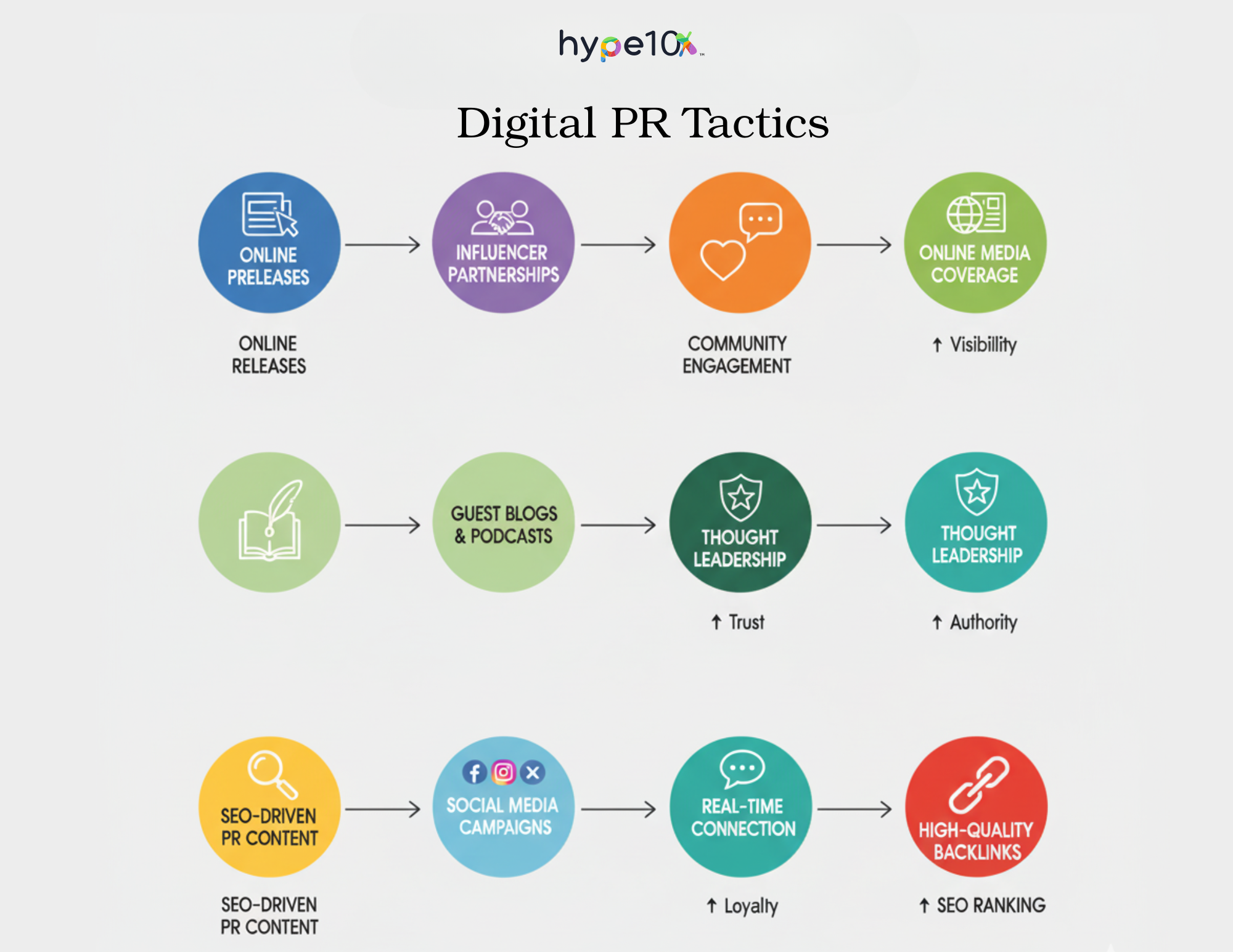
Case Study: Zomato’s Digital PR Brilliance
Zomato, the Indian multinational restaurant aggregator and food delivery company, offers an excellent real-world example of how effectively integrating PR with digital media can drive massive brand presence and customer engagement.
What Worked:
- Hyper-Local & Relatable Content: Zomato excelled at creating quirky, relatable content on social media that tapped into local culture and food preferences. Their use of memes, witty one-liners, and engagement with trending topics on X (formerly Twitter) made their brand feel personal and approachable. For instance, their “Ghar ka khaana” vs. “restaurant food” debates or clever replies to user tweets often went viral, generating immense organic reach.
- Influencer & Micro-Influencer Collaborations: Zomato frequently collaborates with food bloggers and local influencers to review restaurants and promote new features. This strategy leveraged trusted voices within the community, lending credibility and authenticity to their promotions, far more effectively than traditional ads.
- Real-Time Engagement & Crisis Management: Zomato’s social media team is renowned for its quick, often humorous, responses to customer queries and complaints. During moments of minor PR crisis or service glitches, their transparency and swift digital communication helped in managing public perception and maintaining customer trust. Their “no-delivery charge” campaigns, amplified digitally, also created massive buzz and direct customer acquisition.
- SEO-Driven Content: While focused on user experience, Zomato’s platform is inherently SEO-friendly, with restaurant pages and user reviews acting as a rich source of keyword-rich content, ensuring high visibility in search results for local food queries.
What Didn’t / Lessons Learned:
- Balancing Humor and Sensitivity: While Zomato’s quirky tone generally works, there have been instances where some campaigns or social media posts were perceived as insensitive, leading to minor backlashes. The key lesson here is the constant need for audience awareness and cultural sensitivity, especially when operating across diverse regions.
- Managing User-Generated Content: While UGC (user-generated content like reviews) is a strength, managing fake reviews or overly negative feedback requires robust moderation to maintain credibility.
Overall Lesson: Zomato’s success showcases that blending a strong brand voice (PR) with dynamic, real-time, and localized digital engagement (Digital Media) can create a powerful brand narrative that resonates directly with consumers, driving both brand love and business growth.
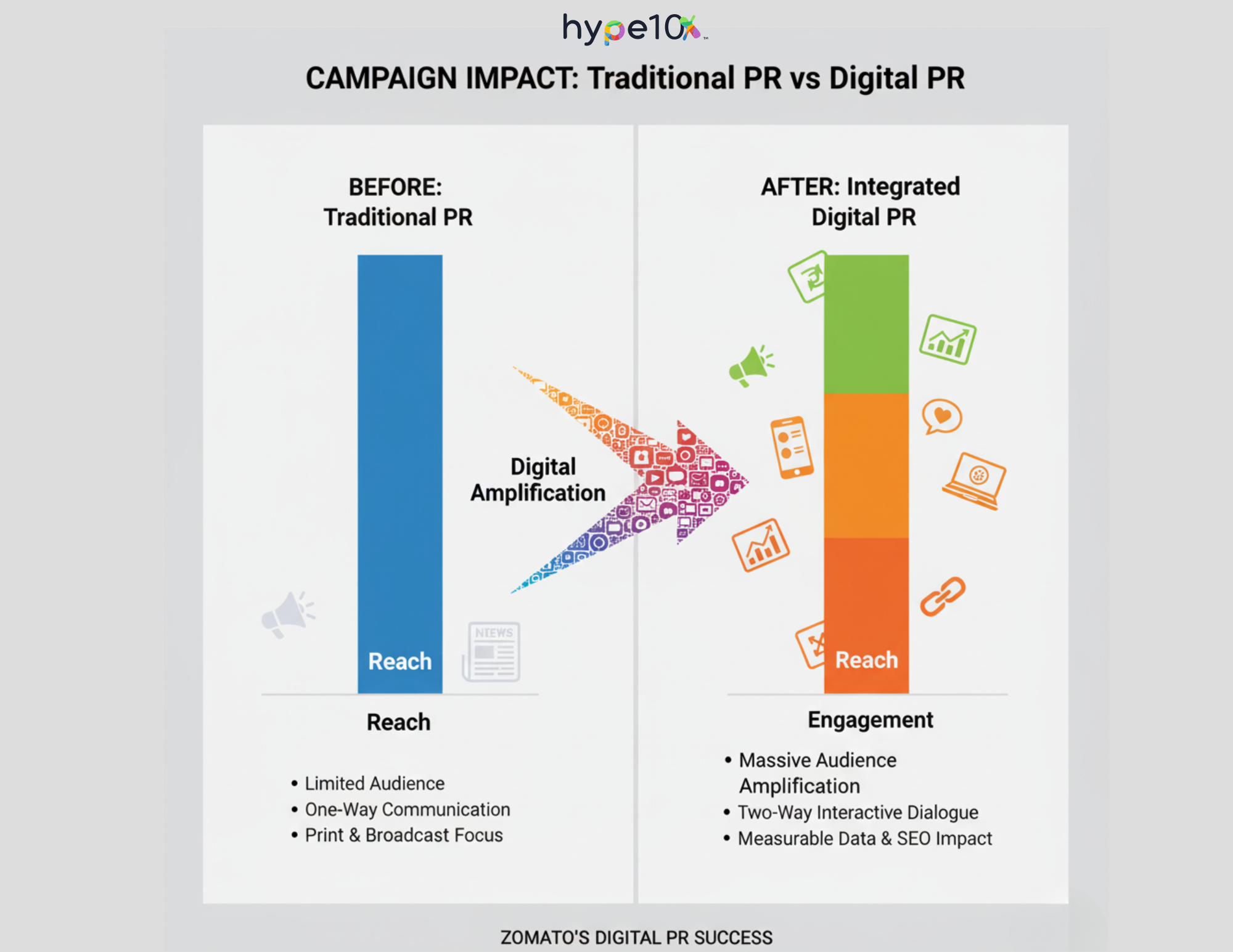
Challenges of Blending PR and Digital Media
While the fusion of PR and digital media offers immense benefits, it also presents a unique set of challenges. One of the most significant is managing negative publicity online. The speed and viral nature of digital platforms mean that a single negative review or complaint can escalate into a full-blown crisis in a matter of hours, a phenomenon often referred to as “cancel culture.” Unlike traditional PR, where a negative story might be confined to a single newspaper, an online backlash can spread across social media, review sites, and forums, requiring constant, real-time monitoring and a swift, transparent response to mitigate damage effectively.
Another major hurdle is information overload and short attention spans. In the digital world, content is everywhere, and audiences are constantly bombarded with messages. This makes it incredibly difficult for a brand’s PR message to cut through the noise and resonate. Content must be not only compelling but also concise and visually engaging to capture attention within a few seconds. This demands a complete rethinking of how stories are told, prioritizing short-form videos, punchy headlines, and shareable graphics over lengthy press releases.
Finally, a major operational challenge is aligning PR storytelling with data-driven digital marketing. PR has traditionally been about building relationships and crafting narratives, which are often qualitative. Digital marketing, on the other hand, is highly quantitative, focused on metrics like clicks, conversions, and ROI. Blending these two requires PR professionals to become more analytical, using data from social listening and web analytics to inform their storytelling and prove the tangible business value of their campaigns. Bridging this gap between creative narrative and cold data is crucial but often a difficult balance to strike.
Best Practices for Blending PR and Digital Media
To successfully blend PR and digital media, businesses should adopt a strategic and holistic approach.
- Consistency is Key: Ensure a unified message, tone, and visual identity across all communication channels—from press releases and corporate websites to social media posts and blog articles. In a fragmented digital landscape, a consistent brand narrative builds trust and recognition.
- Nurture Relationships: While the “gatekeepers” have changed, the importance of relationships has not. Cultivate genuine connections with both traditional journalists and digital influencers. Offer them exclusive content, provide timely information, and be a reliable source. A strong relationship can lead to positive coverage and powerful brand advocacy.
- Monitor in Real-Time: The digital world never sleeps, and neither should your brand’s reputation management. Implement social listening tools to monitor brand mentions, reviews, and industry conversations in real-time. This proactive approach allows you to address negative feedback immediately and capitalize on positive trends.
- Balance Authenticity with Promotion: Today’s audiences are savvy and can spot inauthentic marketing from a mile away. While it’s essential to promote your brand, your messaging must feel genuine. Tell compelling stories, share behind-the-scenes content, and show your brand’s human side. An authentic story resonates far more than a simple sales pitch and builds a loyal community.
- Embrace SEO-Driven PR: Every piece of digital PR content should be created with search engines in mind. This means including relevant keywords, ensuring a clear content structure, and earning high-quality backlinks from reputable sites. By aligning your PR efforts with SEO, you ensure that every campaign not only builds reputation but also contributes to your long-term online visibility and authority.
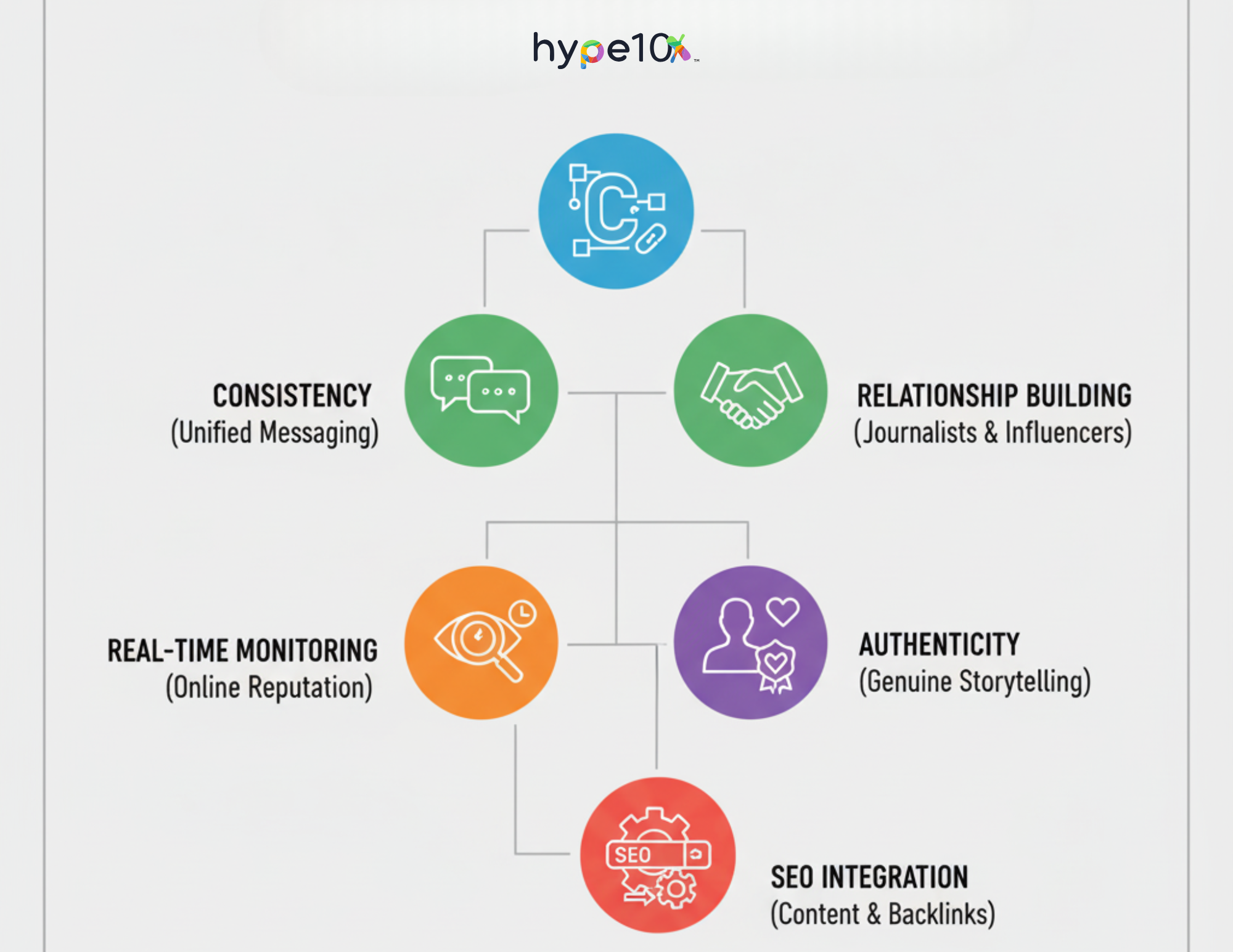
The Future of PR and Digital Media
The future of public relations and digital media is one of deeper integration and a focus on authenticity, driven by technological advancements and shifting consumer behavior.
Rise of AI Tools: Artificial intelligence is set to revolutionize PR workflows, moving beyond basic automation. AI tools will be used for predictive PR, analyzing vast amounts of data to forecast reputational risks or identify viral opportunities before they happen. AI will also assist in real-time media monitoring and even drafting content, freeing up PR professionals to focus on creative strategy and human relationships.
Growth of Micro-Influencers: As audiences become more skeptical of celebrity endorsements, the focus will shift even further toward micro-influencers. These creators, with smaller but highly engaged and niche followings, offer a level of trust and authenticity that is invaluable. Businesses will build partnerships with a network of micro-influencers to reach targeted audiences in a more genuine and effective way.
Interactive Media for PR Campaigns: Traditional press releases will evolve into immersive, interactive experiences. Technologies like Augmented Reality (AR) and Virtual Reality (VR) will enable PR campaigns that let audiences “experience” a product or a brand’s story firsthand. For example, a travel company could offer a VR tour of a destination, or a furniture brand could use AR to let customers visualize products in their own homes.
PR as the Core of Digital Brand Trust: In a world of misinformation, PR’s role in building brand trust will become more critical than ever. The PR function will be central to a brand’s digital presence, ensuring all communication—from social media to customer reviews—is consistent, transparent, and authentic. PR will not just be about getting media coverage, but about solidifying a brand’s integrity and trustworthiness in the eyes of a digitally-savvy public.
Final Thoughts on Digital PR
The digital age has fundamentally reshaped public relations, transforming it from a static, one-way broadcast into a dynamic, two-way conversation. The integration of PR and digital media is no longer optional; it’s essential for any brand that wants to build and maintain relevance. By strategically combining PR’s focus on brand credibility and storytelling with digital media’s unparalleled reach and real-time engagement, businesses can create a powerful and cohesive brand presence. This fusion allows for measurable results, authentic community building, and enhanced online authority. In a crowded digital landscape, a strong reputation is a brand’s most valuable asset. The future of brand communication lies in a unified approach that leverages every online channel to not only tell a story but to earn trust. Businesses that adopt a comprehensive digital PR strategy today will be the ones that thrive tomorrow.
